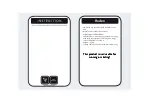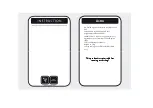
6
5.0.
OPERATION
5.1. CONTROL MODULE ASSEMBLY
5.1.1.
General
The control modules contain the circuitry that senses
the output voltage and determine if correction is
needed. When correction is required this circuit sends a
raise or lower signal to the motor driven variable
transformers. To eliminate unauthorized tampering of
the control module the items marked (
♦
) below are
located behind the front panel.
5.1.2.
Power Pilot Lamps
(A1-LP1)
The POWER lamp on each control assembly lights
when power is present for the motor. This indicates the
voltage regulator is energized.
5.1.3.
Control Pilot Lamps (
A1-LP2)
The CONTROL lamp lights when the control assembly
sense voltage is energized. The control sense voltage
must be energized for automatic correction of voltage
changes to occur.
5.1.4.
Analog Voltmeters
(A1-M1)
This meter shows the output voltages. The meter
senses and displays line-to line voltage.
5.1.5.
Output Voltage Range Toggle Switches
(A1-S1)
♦
With these switches in the OFF position, the control
sense voltage is disconnected and the control pilot
lamp is not illuminated. In this position automatic
correction for voltage changes will not take place and
any change in input voltage will be reflected in output
voltage. The switch should be placed in either the “380”
or “480” position to energize the control assembly
sense voltage and allow automatic correction of voltage
changes.
5.1.6.
Output Voltage Potentiometers
♦
This potentiometer sets the line to line output voltages.
The adjustment range is approximately ± 10% of
selected nominal output voltage.
5.1.7.
Sensitivity Potentiometers
♦
This potentiometer adjusts the voltage regulator’s
output accuracy and therefore sets how much the
output voltage will change before the unit will correct.
5.1.8.
Fuses
(A1-F1 to A1-F4)
♦
The four fuses located on the control module protect
the motor and sense power lines. If the POWER or
CONTROL lights are not lit, and all control settings are
proper, check for a blown fuse.
5.2. SETTING OUTPUT VOLTAGE AND
SENSITIVITY POTENTIOMETERS
Normally, the WHR Series voltage regulator should not
be operated without the front panel(s) of the cabinet in
place. However, during the initial operation of the
regulator, the front panels can be removed to allow
setting the OUTPUT VOLTAGE and SENSITIVITY
potentiometers.
5.2.1.
Energize Regulator
On units equipped with a manual bypass switch ensure
it is in the REGULATOR position. Energize the
regulator power source and place the input circuit
breaker, if so equipped, in the "ON" position. The pilot
lamps should light, indicating that the voltage regulator
is energized and that the control unit is on. If
necessary, move the OUTPUT VOLTAGE RANGE
switch to the desired nominal output voltage position.
The voltmeters will indicate the output voltages.
5.2.2.
Set Output
To adjust the output voltage turn the OUTPUT
VOLTAGE potentiometer clockwise to increase or
counterclockwise to decrease the output voltage, as
indicated on the voltmeter.
5.2.3.
Set Sensitivity
The sensitivity must be adjusted if the voltage regulator
hunts (the motor driven variable transformer section of
the regulator continually cycles back and forth) or if the
regulator allows too great a change from the set
voltage before correction occurs.
Turning the SENSITIVITY control clockwise increases
the sensitivity to maximum (±0.75% to ±1% output
voltage accuracy). For maximum sensitivity, turn the
SENSITIVITY control clockwise slowly to the point
where the POWERSTAT begins to hunt. Turn the
control counterclockwise (CCW) until the hunting stops.
Turn the control an additional 1/4 turn CCW.
5.2.4.
Close
Replace the front cover(s).
5.3. REMOTE SENSING
Normally, these voltage regulators sense and regulate
line to line voltage at the regulator's output terminals, In
some cases better control can be obtained by
regulating the voltage at another point, such as at the
end of long lines between the regulator and the load.
This is known as remote sensing.
If remote sensing is desired, move the wire connected
to terminal 6 to terminal 7 and the wire connected to
terminal 8 to terminal 9 on control module terminal
panel. This will disconnect the control module sense
terminals from the output terminals of the regulator.
Connect remote sensing wires for corresponding line to
line voltage to terminals 6 and 8 on the control
modules.
Summary of Contents for STABILINE WHR34 S Series
Page 2: ...2 ...
Page 16: ...16 11 0 SCHEMATIC For reference only use full size supplied with unit ...
Page 18: ...18 Enclosures A through G continues Note All dimensions are inches millimeters ...
Page 19: ...19 Enclosures A through G continues Note All dimensions are inches millimeters ...
Page 20: ...20 Enclosures DPLUS through GPLUS Note All dimensions are inches millimeters ...
Page 21: ...21 Enclosures DPLUS through GPLUS continues Note All dimensions are inches millimeters ...
Page 22: ...22 Enclosures DD through GG Note All dimensions are inches millimeters ...
Page 23: ...23 Enclosures DD through GG continues Note All dimensions are inches millimeters ...
Page 24: ...24 Enclosures EEE through GGG Note All dimensions are inches millimeters ...
Page 25: ...25 Enclosures EEE through GGG continues Note All dimensions are inches millimeters ...







































